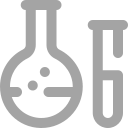
Product Description
GNE-7915 is a potent, selective and brain-penetrant inhibitor of LRRK2 with an IC50 of 9 nM.
IC50 & Target: IC50: 9 nM[1] (LRRK2)
In Vitro: Maintaining the methoxy/fluoro arrangement at C-2′/C-5′ and varying aminoalkyl R1 substitution resultes in single-digit nanomolar LRRK2 cellular activities for GNE-7915 and compound 19. Expanded Invitrogen kinase profiling (187 kinases) at 0.1 μM for both GNE-7915 (100-fold over LRRK2 Ki) and 19 (250-fold over LRRK2 Ki) resultes in only TTK showing greater than 50% inhibition. Selectivity profiling using the DiscoverX KinomeScan55 competitive binding assay panel, which includes 392 unique kinases, is also performed for GNE-7915 at 0.1 μM. Binding of >50% probe displacement is detected for 10 kinases and of >65% for only LRRK2, TTK, and ALK, further supporting the excellent LRRK2 selectivity for GNE-7915. Cerep receptor profiling, including expanded brain panels, suggestes that GNE-7915 and 19 only inhibite 5-HT2B with >70% inhibition at 10 μM. GNE-7915 and 19 are confirmed to be moderately potent 5-HT2B antagonists in vitro functional assays[2].

Information
CAS No1351761-44-8
FormulaC19H21F4N5O3
Clinical Informationclinicalinformation
PathwayAutophagy
TargetLRRK2

Specifications
FormOff-white to light yellow (Solid)
Purity / Grade99.66%
SolubilityDMSO : 14.33 mg/mL (32.32 mM; Need ultrasonic and warming)
Water: < 0.1mg/ml (Insoluble)
SmilesCCNC1=NC(NC2=C(OC)C=C(C(N3CCOCC3)=O)C(F)=C2)=NC=C1C(F)(F)F

Misc Information
Storage Instruction2-8°C
Alternative NamesMethanone, [4-[[4-(ethylamino)-5-(trifluoromethyl)-2-pyrimidinyl]amino]-2-fluoro-5-
methoxyphenyl]-4-morpholinyl�
Observed Molecular Weight443.4
ProtocolAnimal administration [1] Thus, BAC transgenic mice expressing human LRRK2 protein with the G2019S Parkinson's disease
mutation were given either a single oral dose (po) or intraperotineal (ip) injection. Brain (hippocampus) and peripheral (spleen) tissues
were harvested 1-24 h postdose to assess pSer1292 levels and compound concentration. The concentration-dependent knockdown
of pLRRK2 in the brain after oral dosing with GNE-7915 at both 15 and 50 mg/kg and after ip dosing at both 10 and 50 mg/kg.
References[1]. Kavanagh ME, et al. The development of CNS-active LRRK2 inhibitors using property-directed optimisation. Bioorg Med Chem Lett.?2013 Jul
1;23(13):3690-6.
[2]. Estrada AA, et al. Discovery of highly potent, selective, and brain-penetrable leucine-rich repeat kinase 2 (LRRK2) small molecule inhibitors. J Med
Chem. 2012 Nov 26;55(22):9416-33